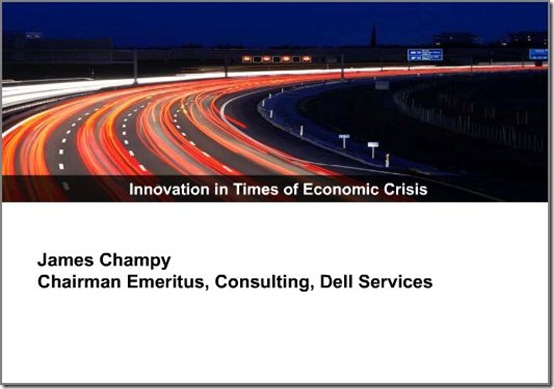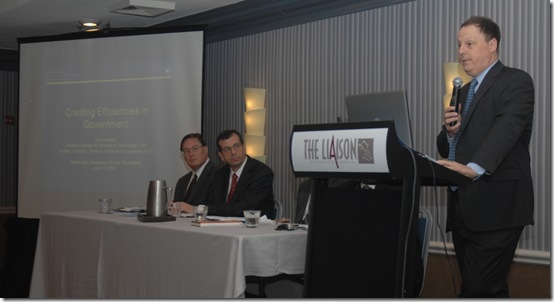Dell Services sponsored a Federal Government Panel event yesterday in Washington, D.C. with the Democratic Leadership Council (DLC) on how to create efficiencies in Government.
Jim Champy, Chairman Emeritus of Dell Services Consulting and Best-selling Author of Reengineering the Corporation, gave the opening keynote address, sharing case studies of lessons learned in the private sector and resulting best practices within the government. Champy discussed the importance of having leaders who have a vision for IT that is tied to business objectives, and shared insights into how agencies could adopt private-sector best practices and quickly realize the benefits.
“Information technology alone is not the enabler to becoming more efficient,” Champy said. “It is coupling IT along with business processes and innovation and combining that with an organization’s employees and its leaders to help execute with a greater sense of purpose is what drives efficiencies within organizations.”
To view Champy’s presentation, go to: www.SlideShare.net/DellServices (or click on the image below):
Champy was followed by a panel of government experts including: Dr. Rick Holgate (Alcohol Tobacco Firearms, ATF, CIO), James F. Williams (acting CIO, NASA Ames Research Center) and Paul Peters (Deputy Assistant Secretary of Defense for Supply Chain Integration). Dell Services President Peter Altabef also participated on the panel.
The panelists were thoughtful and shared valuable insights into their respective agency’s current perspective with regards to IT operations and strategy.
Dr. Rick Holgate talked about how ATF had decided a few years ago to outsource their IT operations. The agency “made a conscious effort to leverage industry,” he said, which has successfully helped drive more efficiency into the contract structure and across the organization.
James Williams of NASA Ames agreed with Champy about the importance of having visionary agency leaders, and he discussed the new approach NASA has taken toward its IT operations. “We didn’t look at NASA as a business. We needed to look at customers within the organization and [ask] ‘how do we do better service management?’ How do we deliver [services] rapidly?’” Williams said the new approach has helped NASA increase innovation in its business practices and increased efficiencies in its overall IT operations.
Paul Peters from DOD gave an overview of the department’s supply chain efforts and extensive breadth of operations, highlighting its participation in national and international humanitarian and wartime efforts. Peters acknowledged the unprecedented demand placed on the department during the past few years and said he expects still greater demand during the next five years. He said the department is serious about its recent efforts to cut budget spending, and he called budget pressures “a great motivator.” In explaining the agency’s outlook on IT, Peters said, “We’re all taxpayers and all have the desire to make sure we’re doing things [right]. The question is: Are you getting the best value?”
With global IT spending currently at $1.2 trillion and growing complexities giving rise to greater inefficiencies and higher costs, Peter Altabef shared Dell Services’ perspective on how best to create efficiencies, noting the government wasn’t the only sector needing to make changes.
“We’ve (Dell) taken out 4,000 servers in the last 18 months. Two-thirds of our software applications have disappeared,” said Altabef, referring to the rapid progress Dell’s IT team has made in standardization and automation. Altabef said the world has entered the “Virtual Era”, and that recent changes are just the beginning of larger changes to come. Success “all depends on processes with which these are all approached.”

